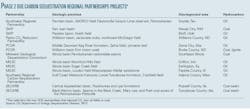DOE partnerships testing CO2 EOR, sequestration synergies
A government-industry initiative is moving into its final testing phase in which researchers examine the potential synergies for simultaneous enhanced oil recovery and carbon dioxide sequestration.
The US Department of Energy organized Regional Carbon Sequestration Partnerships (RCSPs) 7 years ago to compare the merits of various carbon capture and storage (CCS) technologies.
Denbury Resources Inc. of Plano, Tex., is working with RCSP scientists. Independently, the oil company also is pursuing CO2 supplies from power plants and other sources seeking to mitigate greenhouse gas emissions through CCS.
In southwestern Mississippi, RCSP scientists report Cranfield field, which Denbury operates, has stored more than 1 million tonnes of CO2—the first US project to reach that sequestration level.
Advanced Resources International Inc. of Arlington, Va., recently issued a white paper saying US climate legislation, if enacted, potentially could lead to large volumes of captured CO2, accelerating enhanced oil recovery and boosting US oil production. ARI studied the economic and environmental benefits of such a scenario. (See article, p. 52).
DOE's National Energy Technology Laboratory manages the RCSP program, and the seven partnerships are moving into their third phase.
John Litynski, sequestration division manager with DOE's National Energy Technology Laboratory (NETL) in Morgantown, W.Va., said RSCPs concluded Phase 2 validation projects earlier this year.
This article outlines progress of the partnerships that have entered Phase 3, which involves large-scale injections for 10 years.
About half of the nine scheduled projects for Phase 3 already have started field activities or are in the final design stages. The rest are finalizing their site selections, Litynski said.
Cranfield's record
According to the Southeast Regional Carbon Sequestration Project (SECARB), CO2 volumes injected at Cranfield reached the 1 million-tonne landmark last August.
Denbury is a partner in the study, which involves the Upper Cretaceous Lower Tuscaloosa formation, considered representative of CO2 storage opportunities throughout the Gulf Coast.
Cranfield joins four other large-scale sequestration projects under way worldwide: the Sleipner and Snohvit projects in Norway, the Weyburn EOR project in southeastern Saskatchewan, and the In Salah natural gas project in Algeria.
Phase 3 early test operations started at Cranfield in April 2009. SECARB has monitored CO2 injections there since July 2008.
The naturally occurring CO2 comes from Jackson Dome in Mississippi. Injections will continue over several years, SECARB said on its web site. Cranfield combines the use of EOR CO2 injection followed by CO2 injections into deeper, larger-volume saline formations. Researchers are using monitoring instruments nearly 2 miles underground.
Litynski said SECARB researchers reworked many of the old production wells in the field, installing pressure sensors. This instrumentation includes "in-zone" (in the injection zone) and "above zone" (above the injection zone) pressure-response monitoring.
On another SECARB project, Southern Co. and other power company partners plan to build a capture demonstration plant at Alabama Power Co.'s Plant Barry power plant in Bucks, Ala. Alabama Power is a Southern subsidiary.
An estimated 100,000-150,000 tons/year of CO2 will be captured beginning in 2011 for permanent underground storage in a deep saline formation.
The CO2 capture technology, jointly developed by Mitsubishi Heavy Industries Ltd. and Kansai Electric Power Co. Inc., deploys an advanced amine-based solvent that reacts with CO2 in flue gas before being separated and compressed for transportation via pipeline.
The CO2 will be transported from the coal-fired plant to Citronelle oil field, operated by Denbury.
During Phase 2, SECARB completed an injection during 2009 into a coal seam in the southern Appalachian basin. SECARB shut in the well and then reopened it.
"The CO2 actually adsorbed to the coal and then came off the coal," Litynski said. "So it looked like a good opportunity for enhanced coalbed methane recovery by CO2."
SECARB's field activities are directed by the Gulf Coast Carbon Center at the Bureau of Economic Geology at the University of Texas in Austin.
In addition, SECARB is managed by the Southern States Energy Board, an interstate compact of governors and state legislators from 16 southern states, Puerto Rico, and the Virgin Islands.
PCOR tests storage
The Plains CO2 Reduction Partnership (PCOR) also moved into Phase 3 with two large-scale demonstrations to assess storage potential for sequestration of CO2 from human activities.
In the Western Canadian basin demonstration, PCOR researchers collected core samples from a characterization well near Spectra Energy Corp.'s Fort Nelson gas processing plant in northeastern British Columbia.
More than 1 million tons of CO2 from the processing plant will be compressed to a supercritical state and transported 3 miles via pipeline to an injection site.
The CO2, from an acid gas stream of which 85% is CO2 and 15% is hydrogen sulfide, will be injected to a depth of 6,500 ft into the Middle Devonian Elk Point Group formation, where it will dissolve into saline water and fill pores.
The demonstration is designed to provide cost-effective monitoring, mitigation, and verification strategies for large-scale CO2 sequestration in deep brine reservoirs.
The British Columbia demonstration builds on Phase 2 work in which PCOR researchers worked with Apache Canada Ltd. in Zama oil and gas field in northwestern Alberta.
That project involved the injection of acid gas, which is seeing EOR applications (OGJ, Apr. 21, 2008, p. 41).
The Zama acid gas, 67% CO2 and 33% H2S, is produced with nonassociated gas. The area features at least 700 pinnacle reef structures containing oil.
Litynski said, "There is a substantial amount of oil that could be produced in addition to using the pinnacles for H2S and CO2 storage."
The Zama field demonstration is intended to simultaneously improve oil recovery, sequester CO2, and eliminate the accumulation of sulfur on the surface.
Researchers say they hope this approach eventually could be used to manage CO2-rich acid gas streams at thousands of gas processing plants worldwide.
In the other Phase 3 project, PCOR researchers are working to bring 1 million tons of CO2 from a gas processing plant to Bell Creek oil field in southeastern Montana.
Encore Acquisition Co., Fort Worth, planned on using CO2 EOR on Bell Creek field. In November, Denbury announced plans to acquire Encore.
Now on waterflood, Bell Creek field has an estimated 350 million bbl of oil originally in place with 221 million bbl remaining.
Ethanol producer involved
The Midwest Geological Sequestration Consortium (MGSC) is working to determine if sequestration can mitigate the environmental footprint of corn ethanol production at Archer Daniels Midland Co.'s corn wet mill in Decatur, Ill.
In February 2009, Schlumberger Carbon Services drilled an injection well into the Cambrian Mount Simon sandstone, a saline reservoir in the Illinois basin. Scientists estimate the Mount Simon has an estimated CO2 storage capacity of 3-10 billion tonnes.
"We are going to take CO2 from ADM's fermentation process and will be dehydrating, compressing, and injecting 1 million tonnes of CO2 right on site," Litynski said.
CO2 will be injected more than 1 mile underground. Injections are scheduled to begin by early 2011.
On Jan. 31, 2010, MGSC researchers completed a 3D seismic survey at the ADM injection site to determine the structural and stratigraphic configuration of rocks where CO2 will be injected.
A CO2 dehydration-compression plant will be constructed near the corn wet mill, and a 3,200 ft pipeline will be built to transport CO2 to the injection well.
Safe storage
Across all seven RCSPs, researchers are working on modeling, monitoring, and risk assessment technologies to ensure safe carbon storage.
The partnerships compiled lessons from Phase 2 field tests into a best-practices manual, Litynski said.
Researchers also completed the second version of the Carbon Sequestration Atlas of the US and Canada. The version released in May 2009 uses a Google Earth platform to make the atlas easy to use.
"We updated the methodology slightly," Litynski said. "We also included a number of sequestration possibilities offshore in the Gulf of Mexico as well as updated information about onshore formations available for storage."
More Oil & Gas Journal Current Issue Articles
More Oil & Gas Journal Archives Issue Articles
View Oil and Gas Articles on PennEnergy.com

